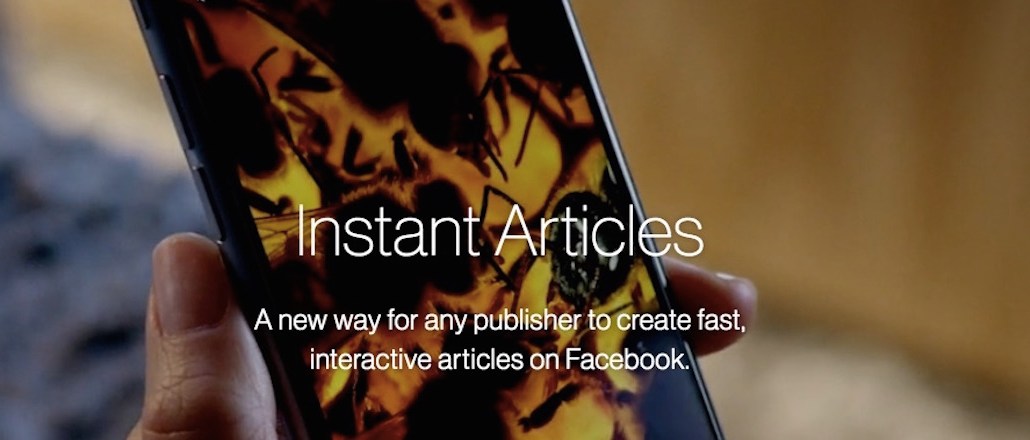‘Think monetization from day one’: Facebook’s tips for publishers using Instant Articles

Last week, Facebook opened its Instant Articles format to all publishers. Using Instant Articles, they can now show readers using Facebook mobile a fast-loading version of their posts, while still also displaying some of their ads and measuring pageviews. Previously, Instant Articles was only available to a select number of official publisher partners.
“Only now Instant Articles has been released widely will we really start to scale it,” said Yoav Arnstein, who leads Facebook’s publishers advertising solutions across Europe.
Digiday spoke to Arnstein about what tips he’d give those starting to experiment with content on the platform.
“Think monetization from day one.”
For publishers wanting to create a good, fast reading experience, publishing directly to Facebook via Instant Articles offers both audience reach and page-load speed. But investing in creating content for off-site environments they can’t control, either commercially or editorially, comes with its own set of risks.
Facebook has responded by opening up more commercial opportunities for publishers within Instant Articles. There’s now the option to run branded content via Instant Articles, a development publishers like the Guardian have been wanting for some time. The Guardian is among those to have gone all-in on Instant Articles and has been running ads via its pages for some time, though it hasn’t opened up on the results. Branded content will open yet another revenue stream for the publisher.
Other media outlets, like political publisher La Libération in France, have been more vocal about how much money they can make from Instant Articles. Libération’s head of digital, Xavier Grangier, recently told Digiday, that it is currently making the same amount of revenue on Instant Articles as it is on its mobile Web pages, even though the latter have multiple sources of revenue, like promoted links served by companies like Outbrain.
Publishers can also run rich media and their own direct-sold ads and keep 100 percent of the revenue, and they can also run pre-roll ads within video content. Or they can choose to have Facebook serve their ads on their behalf via Audience Network for a revenue share. The formats and possibilities will likely keep on coming.
Arnstein said a lot of lessons have been learned during the beta period, from which he believes publishers that are only just joining, will benefit. One such insight is for publishers to think monetization first when approaching what kind of content they choose to publish. But before rushing in publishers would do well to think about what would work well in terms of the ad experience itself.
“Publishers must think monetization from day one, because publishing in the overall experience is almost a no brainer — it’s a clean, fast user experience. But you know you will need to monetize it at some point, so you may as well do it by design as you approach it,” he said.
Match the native ad format to the reader experience.
Now that publishers can run branded content along with standard ads on Instant Articles, it’s important the quality of the ad matches the quality of editorial, said Arnstein. Already half of the publishers that work with Facebook via Audience Network only run native format ads, and represent most (83 percent) of the entire network’s impressions.
Also worth noting is that the typical consumer reading experience on Facebook varies depending on individual preferences, and certain ad formats work better in some situations than others, said Arnstein.
“We’ve seen different things that work,” he said. “There are obviously some rules on what you can and can’t do but there is flexibility and certain things work better than others. We’ve developed some good best practices.”
For example, Facebook has examined different ways consumers navigate through content (what Arnstein refers to as “content flow types”) and found that certain native ad formats work best. “Depending on the content you want to publish and the way you think about the flow of the user consuming the content, we will recommend different types of integrations.” he added.
Be collaborative with other publishers.
A final tip from Arnstein is one he says he gives to his own children: Speak to as many people as you can and then form your own opinion. That’s the same advice he’d extend to publishers that haven’t yet tried Instant Articles.
“We’ve had a real range of enough publishers now in every market,” he said. “News publishers, more entertainment-focused publishers, and ones which rely deliberately on Facebook as their main source of traffic. They’ve all experimented. The first advice I’d give is to go and talk to these publishers and learn from what they’ve done.”
More in Media

Publishers are hunting for AI prompt data — now they’re starting to get it from third-party companies
Publishers are finally gaining some visibility into AI search, as new prompt data tools crack open a black box.

Digiday+ Research: Publishers’ growing focus on video doesn’t translate to social platforms
Major publishers have made recent investments in vertical video, but that shift is not carrying over to social media platforms.

Technology x humanity: A conversation with Dayforce’s Amy Capellanti-Wolf
Capellanti-Wolf shared insight on everything from navigating AI adoption and combating burnout to rethinking talent strategies.





